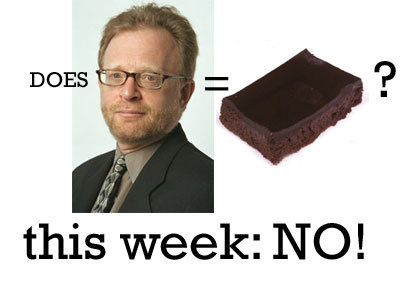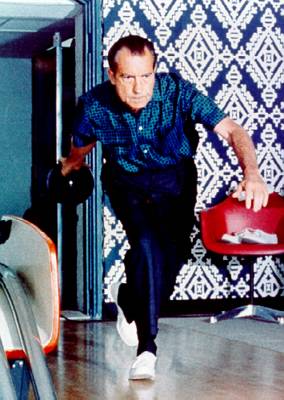
WEEKLY QUESTION: Will this week’s NYTBR reflect today’s literary and publishing climate? Or will editor Sam Tanenhaus demonstrate yet again that the NYTBR is irrelevant to today’s needs? If the former, a tasty brownie will be sent to Mr. Tanenhaus’ office. If the latter, the brownie will be denied.
THE COLUMN-INCH TEST:
Fiction Reviews: 4 one-page reviws, 6 half-page reviews, 1 microscopic blurb in the Children’s Books section (0.2 pages), 1 half-page crime roundup. (Total books: 16. Total space: 7.7 pages.)
Non-Fiction Reviews: 3 two-page reviews, 1 – 1 1/2 page review, 5 one-page reviews, 2 half-page reviews, 1 page roundup on CIA books. (Total books: 18. Total space: 14.5 pages.)
While the disparity here is, as usual, completely out of step with contemporary fiction (case in point: the NYTBR is only now getting around to Meg Wolitzer’s The Position, a book that’s been out for over a month) and very much in favor of non-fiction (a pathetic 34.7% of this week’s coverage is fiction-oriented), I should point out that this is the first NYTBR I’ve seen under Tanenhaus’ tenure that doesn’t feature some unrelated, blustery essay on politics wasting precious column inches. In fact, Tanenhaus can be applauded for getting William Safire and Christopher Hitchens to tie their essays into books.
But one wonders why Tanenhaus is so committed to this type of content. Have you noticed that the letters that come in almost never get excited about any of these essays? (This week’s letters deal with Joe Queenan’s essay on ghost writers and Zoe Heller’s review of Saturday.)
So while I give Sam props for dumping the tangential nonsense, as the great Vince Lombardi once said, “If winning isn’t everything, why do they keep score?” I want Sam to win, but winning means giving your all. And then some.
Brownie Point: DENIED!
THE HARD-ON TEST:
This test concerns the ratio of male to female writers writing for the NYTBR.
Only three women (including the redoubtable Lizzie) contributing to fiction coverage this week (not counting Claire Whitcomb’s microscopic blurb)? Only one (one!) woman contributing to nonfiction? What’s a girl got to do to get a gig with Sam?
Sam should be ashamed of himself.
Brownie Point: DENIED!
THE QUIRKY PAIR-UP TEST:
Fortunately, this week’s slate of contributors makes up for the other two tests. It’s nice to see a full-length review from an illustrator in the Children’s Books section, particularly because his sensibility reveals the unexpected glimpse of an insider. While it’s a shame to see Lizzie Skurnick’s review cramped to a half page, she manages to bring in antecedents and humor into the claustrophobic confines while covering William Henry Lewis’ I Got Somebody in Staunton. Choire Sicha injects sociological introspection into his review of The Position and even manages to coin a new term for people in Connecticut to scratch their pates over: “generational dudgeon.” I plan to use these two words myself the next time I find myself trapped in a conversation with an unimaginative person. And it’s good to see Christopher Hitchens being given a break from writing sensational obituaries.
It’s a steady crop and a fair cop.
Brownie Point: EARNED!
CONTENT CONCERNS:
William Safire’s comparative review does a solid job of introducing the layman to privacy concerns.
Long-time NYTBR readers are aware of David Kamp’s inability to separate fact from fiction. What’s more, Kamp’s widely reported stalking of Neal Pollack sheds an additional doubt on Kamp’s credibility as a NYTBR regular. Apparently, Sam Tanenhaus didn’t get the memo that explained how questionable David Kamp was and has seen fit to let him run amuck with Ruth Reichl’s third memoir.
Kamp starts off with the preposterous notion that most food writers (including Kamp himself?) are “doubtful of the very validity of their profession.” Even if we were to accept the strange notion that food critics suffer from rampant insecurity, what does this have anything to do with Riechl or gourmet writing? Isn’t any gourmand, by way of her tastes and sensibilities, absolutely confident about the foods that permeate her palate? And isn’t this the very quality that makes food writing so exciting?
I grew very uncomfortable reading Kamp’s review. He seems more concerned with Reichl’s physical appearance (the word “bra” can be found twice and there are no limits to Kamp judging Reichl on her sexuality and her cascading “dark curls”), rather than her qualities as a food writer or a memorist. Factor in Kamp’s inability to mention Jayson Blair’s name (“He Who Shall Not Be Mentioned”) and the Gray Lady glorymongering (apparently, Reichl’s stint at the Times is the most fascinating part of the memoir), and we see that Kamp is a man more concerned with voicing his own neuroses rather than assessing a memoir by a seminal gourmand. Perhaps he and Jonathan Franzen might want to sign up for several group therapy sessions, if only to spare us the unpleasant personal revelations.
Personal sartorial choices are also the linchpin of Ben MacIntyre’s review of a Geoffrey Spicer-Simson, which, despite the headline’s playful riff on the John Ford film, spends too much time dwelling on Spicer-Simson’s skirt, as if this, rather then Spicer-Simson’s actions, was where the ultimate meaning behind Lake Tanganyika can be found.
It’s good to see Richard K. Morgan getting a full-page review, particularly when the subhead describes it as “a dystopian novel” rather than a “science-fiction novel.” Tanenhaus is showing signs of thinking outside the box of genre ghettoization. We award him a special half brownie point for doing so.
CONCLUSIONS:
This week’s NYTBR has finally recalibrated its pages to complete and total review coverage. And, as such, it’s the closest that Tanenhaus has come to earning his brownies. But with fiction coverage still caged within soundbyte-sized reviews, not given the room to expand that previous editors had allowed, it still doesn’t cut the mustard for a leading national newspaper.
But if the NYTBR continues further in this direction, and Tanenhaus takes more chances, then we will be more than happy to fulfill our part of the bargain.
Brownie Points Earned: 1.5
Brownie Points Denied: 2

 It wasn’t easy. You see, I hadn’t entirely come to terms with Japantown Bowl’s demise.
It wasn’t easy. You see, I hadn’t entirely come to terms with Japantown Bowl’s demise. 
